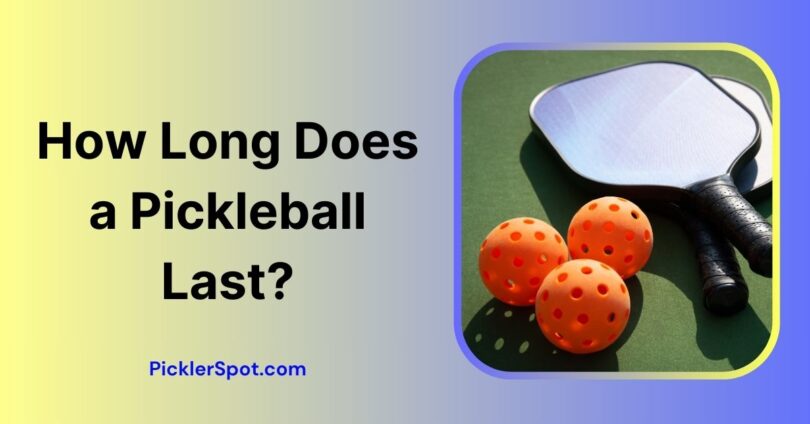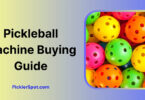In a Pickleball court, nothing is immune to laws of physics that impose general wear and tear after a rigorous session.
Matter of fact, even if it weren’t a rigorous session, one way or another your equipment is still going to suffer from inevitable damage, especially if it’s the ball that undoubtedly is exposed the most to the external stimuli.
Subsequently, the phenomenon of material wearing out will drastically impact how you carry out your session so it’s in your best interest that you carry on reading this article on “How long does a Pickleball last”, i will be throwing in a couple of tips on how you can prolong its life expectancy so you could save a couple of bucks in the long run.
What Is Pickleball Made of?
Before you dive into its intricacies relating to its lifespan, let’s find out what it’s made of.
A typical Pickleball is generally a unique hollow ball with at least 20 holes all across its structure and can be easily manipulated by the win. Depending on the brand you may have bought, a pickleball is made of polypropylene compound or ABS material.
Although there is no specific weight threshold, most of these pickleballs weigh around 25 grams in general, so it’s safe to assume they are considerably lightweight and vulnerable to blunt forces.
LifeSpan of A Pickleball
A typical perforated ball made of ABS or Polypropylene material would easily last up to 25 sessions outdoors and 35 sessions indoors. The reason it has a discrepancy in its lifespan when used outdoors as compared to indoors is due to three main factors,
1. Ambient Temperature
Indoors Pickleball courts are conditioned to provide favorable temperatures that prevent polar extremes for the players partaking in the sessions. This implies the ball stays at room temperature throughout the game.
Outdoor Pickleball sessions are a completely different beast, in fact, they drastically increase their vulnerability factor to a great extent as plastic material suffers from shrinkage or expansion corresponding to the temperature it is used in.
This change of temperature exacerbates its integrity causing minor cracks to appear all across its body which ruins its composition altogether.
2. UV Radiation
Direct sunlight is an arch nemesis of ABS or Polypropylene material, in fact, it effectively changes its composition making it fragile especially if you are playing in hotter or humid regions.
Indoor Pickleballs are generally immune to these fiascos since there is no chance of UV radiation impacting their life expectancy, henceforth, there is a higher chance they would survive more sessions.
3. Court Surface
Everyone knows outdoors is generally played in a harsher environment since the court itself is made from rough, harsher material which has higher thermal mass and lesser shockwave absorption rate causing the ball to pop and bounce higher than usual.
Indoor courts are much more forgiving as the surface is made from softer wood, so even if you are playing aggressively, your ball would last a bit over 30 sessions even if it’s made from a poor brand.
These are just those factors that differentiate the life expectancy of an outdoor Pickleball from its indoor Counterpart. Now let’s dive down on elements that affect a Pickleball’s life expectancy directly,
1. Playstyle
Your playstyle directly correlates to your Pickleball’s health, in fact, the harsher you are the more you would lose out on balls as they would become worn out quickly. While in a competitive league, it’s quite inevitable that you would follow an aggressive playstyle with snappier volleys in between.
If you want your Pickleball to survive a bit longer, try to follow a laid-back playstyle when playing in a recreational manner, in that case, the minor cracks won’t get aggravated as fast as they would whenever you are hitting it with force.
2. Storage Issues
While an equipment bag may cost a pretty penny, it’s worth noting that using it would let you store your Pickleball equipment in a safe manner. While many players insist that carrying equipment bags makes them uncomfortable, the benefit it provides might supersede the comfort factor as it keeps your paddle and balls safe and secure.
It also gives off a sense of sportsmanship as it displays how committed you are to your sports. Alternatively, you could also keep your equipment in a locker in case carrying it around feels like quite a headache for you.
3. Frequency Of Usage
Lastly, the most obvious factor affecting its lifespan is how frequently you use the same ball over and over again. Make sure you carry multiple balls and cycle them after a couple of sessions, in that way they could easily last more and provide you more bang for your buck.
Furthermore, avoid lending your Pickleball to others, as it may lead to carelessness or improper usage altogether.
How To Identify An Expired Pickleball?
Regardless of your expertise, there are some ways a Pickleball being out of order could be identified.
1. Tacky Bounce Rate
The first and foremost symptom of a Pickball that has been completely worn out is losing its core integrity allowing it to bounce improperly whenever it is hit with a Paddle.
In general, you would either see it bounce poorly or lower than usual on the surface which might indicate that it is high time that you replace the ball.
2. Weird Feedback
The sound feedback would be completely off by the miles due to cracks appearing on the ball as a result of integrity failure.
This is also a factor that could be easily identified right away without needing prior expertise.
3. Disfigurement Of Shape
Closely examining the ball for any cracks or crevices would also indicate that there is shape disfigurement in the shape of a ball which may arise after going through a rough ordeal all day long.
How Long Does a Pickleball Last? Bottom Line
Strategically, if you are playing or preparing for competitive leagues, it’s in your best interest that you change your equipment every now and then. Sports equipment undoubtedly suffers from cracks and chip damage which is pretty much inevitable.
So if you want to get the most optimal experience, make sure you Carry replacement pickleballs in your pickleball bag.









